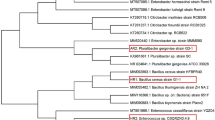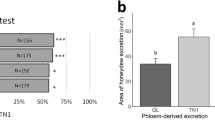Abstract
This study examines allelopathic potential of genetically modified rice. The experiment was conducted on two isogenic lines Bacillus thuringiensis (Bt) and non-Bacillus thuringiensis (non-Bt). Both isogenic lines have same allelopathic ability before insect feeding and after limited insect feeding (Spodoptera litura) non-Bt rice genotype demonstrates more allelopathic potential. The S. litura cannot feed Bt rice genotype. The role of shoot herbivory in allelopathic induction is further supported when Bt plants also exhibited higher allelopathic potential after insect regurgitant application to the damaged leaves. Allelopathic potential was assessed through several methods after treatments of mechanical damage, insect feeding and insect regurgitant application to damaged rice leaves. Rhizosphere soil and leaf leachates of non-Bt rice cultivar exhibited higher allelopathic potential on lettuce and barnyard grass after herbivore feeding. Enzyme activities (PAL and C4H) responsible for biosynthesis of phenolic compounds and their concentration were significantly higher in non-Bt plant after herbivore feeding and attain the same level in Bt plants after insect regurgitant application to damaged leaves. Similarly, genes (OsPAL and OsCYC1) responsible for biosynthesis of allelopathic compounds showed high expression in non-Bt plants after herbivore feeding. Our results indicate that herbivore feeding enhance rice allelopathic potential and no insect feeding as incase of Bt plants may reduce allelopathic potential of genetically modified rice.



Similar content being viewed by others
References
Agrawal AA (2000) Overcompensation of plants in response to herbivory and the by-product benefits of mutualism. Trends Plant Sci 5(7):309–313
Agrawal A, Karban R (1999) Why induced defenses may be favored over constitutive strategies in plants. In: Tollrian R, Marvell CD (eds) The ecology and evolution of inducible defenses. Princeton University Press, Princeton, pp 45–61
Bais HP, Walker TS, Stermitz FR, Hufbauer RA, Vivanco JM (2005) Enantiomeric-dependent phytotoxic and antimicrobial activity of (±)-catechin. A rhizosecreted racemic mixture from spotted knapweed (vol 128, pg 1173, 2002). Plant Physiol 137(4):1485
Baldwin IT, Preston CA (1999) The eco-physiological complexity of plant responses to insect herbivores. Planta 208(2):137–145
Barton KE, Bowers MD (2006) Neighbor species differentially alter resistance phenotypes in Plantago. Oecologia 150(3):442–452
Brader G, Tas E, Palva ET (2001) Jasmonate-dependent induction of indole glucosinolates in Arabidopsis by culture filtrates of the nonspecific pathogen Erwinia carotovora. Plant Physiol 126(2):849–860
Crawley MJ (1989) Insect herbivores and plant population dynamics. Annu Rev Entomol 34:531–564
Dicke M, van Poecke RMP, de Boer JG (2003) Inducible indirect defence of plants: from mechanisms to ecological functions. Basic Appl Ecol 4(1):27–42
Fujii Y, Furubayashi A, Hiradate S (2005) Rhizosphere soil method: a new bioassay to evaluate allelopathy in the field. Proceedings of the 4th World Congress on Allelopathy, “Establishing the Scientific Base”, Wagga Wagga, New South Wales, Australia, pp 490–492
Hamilton EW, Frank DA (2001) Plant defoliation promotes microbial nitrogen cycling through increased root exudation of carbon. Ecology 82:2397–2402
Haukioja E (1991) Induction of defenses in trees. Annu Rev Entomol 36:25–42
Inderjit (1996) Plant phenolics in allelopathy. Bot Rev 62(2):186–202
Jones T, Kulseth S, Mechtenberg K, Jorgenson C, Zehfus M, Brown P, Siemens DH (2006) Simultaneous evolution of competitiveness and defense: induced switching in Arabis drummondii. Plant Ecol 184(2):245–257
Kato-Noguchi H, Ino T (2003a) Rice seedlings release allelopathic substances. Biol Plant 46(1):157–159
Kato-Noguchi H, Ino T (2003b) Rice seedlings release momilactone B into the environment. Phytochemistry 63(5):551–554
Kato-Noguchi H, Ino T (2005) Concentration and release level of momilactone B in the seedlings of eight rice cultivars. J Plant Physiol 162(9):965–969. doi:10.1016/j.jplph.2005.02.007
Kato-Noguchi H, Macias FA (2005) Effects of 6-methoxy-2-benzoxazolinone on the germination and alpha-amylase activity in lettuce seeds. J Plant Physiol 162(12):1304–1307
Kato-Noguchi H, Ino T, Ichii M (2003) Changes in release level of momilactone B into the environment from rice throughout its life cycle. Funct Plant Biol 30(9):995–997
Kato-Noguchi H, Takaoka T, Izumori K (2005) Psicose inhibits lettuce root growth via a hexokinase-independent pathway. Physiol Plant 125(3):293–298
Kato-Noguchi H, Kujime H, Ino T (2007) UV-induced momilactone B accumulation in rice rhizosphere. J Plant Physiol 164(11):1548–1551
Kessler A, Baldwin IT (2002) Plant responses to insect herbivory: the emerging molecular analysis. Annu Rev Plant Biol 53:299–328
King EG, Leppla NC (1984) Advances and challenges in insect rearing. Agric Res Serv, USDA, US Government Printing Office, Washington, DC, 306 p
Lamb CJ, Rubery PH (1975) A spectrophotometric assay for trans-cinnamic acid 4-hydroxylase activity. Anal Biochem 68:554–561
Livak KJ, Schmittgen TD (2001) Analysis of relative gene expression data using real-time quantitative PCR and the 2(T)(-Delta Delta C) method. Methods 25(4):402–408
Luo H, Song F, Zheng Z (2005) Overexpression in transgenic tobacco reveals different roles for the rice homeodomain gene OsBIHD1 in biotic and abiotic stress responses. J Exp Bot 56:2673–2682
Mahmood K, Khan M, Song Y, Ijaz M, Luo S, Zeng R (2013a) UV-irradiation enhances rice allelopathic potential in rhizosphere soil. Plant Growth Regul 71(1):21–29
Mahmood K, Khan MB, Ijaz M, Habib U, Athar M, Song YY, Luo SM, Zeng RS (2013b) Exogenous application of signaling compounds enhances rice allelopathic potential in rhizosphere soil. Int J Agric Biol 15(6):1319–1324
Marschner H, Romheld V, Cakmak I (1987) Root induced changes of nutrient availability in the rhizosphere. J Plant Nutr 10(9–16):1175–1184
McKhann HI, Paiva NL, Dixon RA, Hirsch AM (1998) Expression of genes for enzymes of the flavonoid biosynthetic pathway in the early stages of the Rhizobium-legume symbiosis. In: Manthey JA, Buslig BS (eds) Flavonoids in the Living System, Advances in Experimental Medicine and Biology, vol 439. Springer, US, pp 45–54
Olff H, Ritchie ME (1998) Effects of herbivores on grassland plant diversity. Trends Ecol Evol 13(7):261–265
Paige KN (1999) Regrowth following ungulate herbivory in Ipomopsis aggregata: geographic evidence for overcompensation. Oecologia 118(3):316–323
Paige KN, Whitham TG (1987) Over compensation in response to mammalian herbivory: the advantage of being eaten. Am Nat 129(3):407–416
Rasmann S, Kollner TG, Degenhardt J, Hiltpold I, Toepfer S, Kuhlmann U, Gershenzon J, Turlings TCJ (2005) Recruitment of entomopathogenic nematodes by insect-damaged maize roots. Nature 434(7034):732–737
Rice EL (1987) Alleopathy—an overview. ACS Symp Ser 330:8–22
Ridenour WM, Callaway RM (2001) The relative importance of allelopathy in interference: the effects of an invasive weed on a native bunchgrass. Oecologia 126(3):444–450
Saxena D, Flores S, Stotzky G (2002) Bt toxin is released in root exudates from 12 transgenic corn hybrids representing three transformation events. Soil Biol Biochem 34(1):133–137
Schmidt S, Baldwin I (2009) Down-regulation of systemin after herbivory is associated with increased root allocation and competitive ability in Solanum nigrum. Oecologia 159(3):473–482
Seal AN, Haig T, Pratley JE (2004a) Evaluation of putative allelochemicals in rice root exudates for their role in the suppression of arrowhead root growth. J Chem Ecol 30(8):1663–1678
Seal AN, Pratley JE, Haig T, An M (2004b) Identification and quantitation of compounds in a series of allelopathic and non-allelopathic rice root exudates. J Chem Ecol 30(8):1647–1662
Seal AN, Pratley JE, Haig T, Lewin LG (2004c) Screening rice varieties for allelopathic potential against arrowhead (Sagittaria montevidensis), an aquatic weed infesting Australian Riverina rice crops. Aust J Agric Res 55(6):673–680
Shelton AM, Zhao JZ, Roush RT (2002) Economic, ecological, food safety, and social consequences of the deployment of bt transgenic plants. Annu Rev Entomol 47:845–881
Siemens DH, Garner SH, Mitchell-Olds T, Callaway RM (2002) Cost of defense in the context of plant competition: brassica rapa may grow and defend. Ecology 83(2):505–517
Swihart RK, DeAngelis DL, Feng Z, Bryant JP (2009) Troublesome toxins: time to re-think plant-herbivore interactions in vertebrate ecology. BMC Ecol 9:5
Trevors JT, Kuikman P, Watson B (1994) Transgenic plants and biogeochemical cycles. Mol Ecol 3(1):57–64
Turlings TJ, McCall P, Alborn H, Tumlinson J (1993) An elicitor in caterpillar oral secretions that induces corn seedlings to emit chemical signals attractive to parasitic wasps. J Chem Ecol 19(3):411–425
Vandegehuchte ML, de la Pena E, Bonte D (2010) Relative importance of biotic and abiotic soil components to plant growth and insect herbivore population dynamics. Plos One 5(9):e12937
Acknowledgments
This research was supported by the National 973 project of China (2006CB100200), Natural Science Foundation of China (30870390, 30670331). Guangdong Natural Science Foundation of China (8451064201001012), Guangdong Science and Technology Plan Project (2008A030101008, 2008B021500001) and Doctoral Foundation of the Ministry of Education of China (20060564017).
Author information
Authors and Affiliations
Corresponding author
Rights and permissions
About this article
Cite this article
Mahmood, K., Khan, M.B., Ijaz, M. et al. Molecular, biochemical and bioassay based evidence of lower allelopathic potential in genetically modified rice. Plant Growth Regul 74, 73–82 (2014). https://doi.org/10.1007/s10725-014-9898-8
Received:
Accepted:
Published:
Issue Date:
DOI: https://doi.org/10.1007/s10725-014-9898-8




